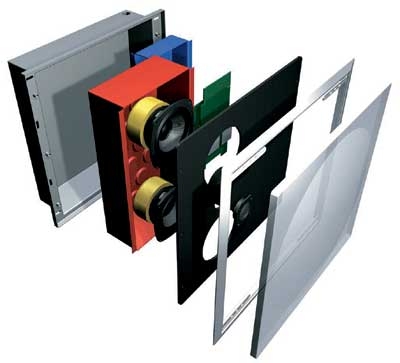The Case of the Invisible Speakers Page 4
Back SupportThere is less debate about the use of "back boxes," which are enclosures that can be mounted behind the drivers to help control the acoustic variations of wall and ceiling cavities. Because the characteristics of the back box are known, the speaker can be optimized to achieve predictable sonic performance, help reduce acoustic reverberation within the walls, and decrease the sound bleeding into adjacent rooms. Also, many commercial - and some residential - installations must use steel back boxes to meet fire and building codes.  Meridian's DSP 420 in-wall speaker (shown here with a sealed preconstruction enclosure) has separate built-in amplifiers for the bass and treble.
Meridian's DSP 420 in-wall speaker (shown here with a sealed preconstruction enclosure) has separate built-in amplifiers for the bass and treble.
"A speaker has to have its back wave contained, regardless of whether it's an in-wall, an on-wall, or a freestanding model," Gornik says. "Otherwise you have a lot of rear acoustic energy going into the wall and vibrating whatever's back there, whether it's drywall or studs, which creates a subtle form of distortion that reduces the clarity you should be hearing."
Atlantic Technology's Tribeman is also a back-box believer. "You don't know what's behind the wall or how much space there is. When you have a sealed box, you know what you're working with." Some companies, such as Triad and Focal-JMlab, believe in the concept so strongly that their in-wall and ceiling speakers include cabinets that can be mounted directly in the wall.
Producing deep bass in a highly resonant environment like walls is also a challenge, so maybe it's no surprise that many installers prefer using freestanding subwoofers, which can generally be hidden fairly easily. But more and more people want subs that can be placed in walls, in the floor, and even in ceilings. Many of the companies that offer in-wall speakers, such as Atlantic Technology, Boston Acoustics, Niles, and SpeakerCraft, also offer in-wall subs, typically with an external power amplifier that can be placed out of sight.
"We tend to use freestanding subwoofers, and sometimes we'll open up the floor, install a standard subwoofer, and put a cold-air return cover over it," Progressive Audio's Ranney says. "But it's pretty rare for us to do an in-wall subwoofer. That's an uphill battle, because the sub is going to vibrate a big area of drywall, and that adds a lot of colorations to the sound. To do it right, you might have to rebuild the wall. So a sub in the drywall would be our last resort, but it's still better than no sub at all."




























































